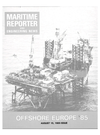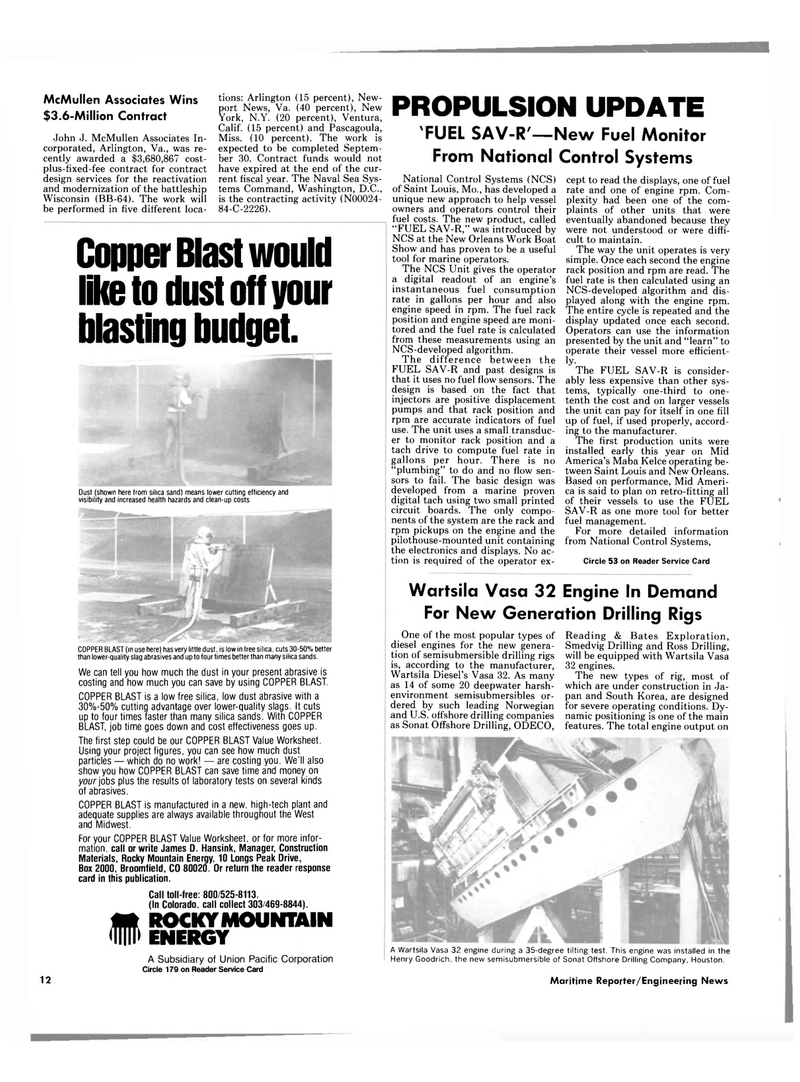
Page 10: of Maritime Reporter Magazine (August 15, 1985)
Read this page in Pdf, Flash or Html5 edition of August 15, 1985 Maritime Reporter Magazine
McMullen Associates Wins $3.6-Million Contract
John J. McMullen Associates In- corporated, Arlington, Va., was re- cently awarded a $3,680,867 cost- plus-fixed-fee contract for contract design services for the reactivation and modernization of the battleship
Wisconsin (BB-64). The work will be performed in five different loca- tions: Arlington (15 percent), New- port News, Va. (40 percent), New
York, N.Y. (20 percent), Ventura,
Calif. (15 percent) and Pascagoula,
Miss. (10 percent). The work is expected to be completed Septem- ber 30. Contract funds would not have expired at the end of the cur- rent fiscal year. The Naval Sea Sys- tems Command, Washington, D.C.. is the contracting activity (N00024- 84-C-2226).
Copper Blast would like to dust off your blasting budget.
Dust (shown here from silica sand) means lower cutting efficiency and visibility and increased health hazards and clean-up costs.
COPPER BLAST (in use here) has very little dust, is low in free silica, cuts 30-50% better than lower-quality slag abrasives and up to four times better than many silica sands.
We can tell you how much the dust in your present abrasive is costing and how much you can save by using COPPER BLAST.
COPPER BLAST is a low free silica, low dust abrasive with a 30%-50% cutting advantage over lower-quality slags. It cuts up to four times faster than many silica sands. With COPPER
BLAST, job time goes down and cost effectiveness goes up.
The first step could be our COPPER BLAST Value Worksheet.
Using your project figures, you can see how much dust particles — which do no work! — are costing you. We'll also show you how COPPER BLAST can save time and money on your jobs plus the results of laboratory tests on several kinds of abrasives.
COPPER BLAST is manufactured in a new. high-tech plant and adequate supplies are always available throughout the West and Midwest.
For your COPPER BLAST Value Worksheet, or for more infor- mation. call or write James D. Hansink, Manager, Construction
Materials, Rocky Mountain Energy, 10 Longs Peak Drive,
Box 2000, Broomfield, CO 80020. Or return the reader response card in this publication.
Call toll-free: 800/525-8113. (In Colorado, call collect 303/469-8844).
ROCKY MOUNTAIN ENERGY
A Subsidiary of Union Pacific Corporation
Circle 179 on Reader Service Card ®
PROPULSION UPDATE 'FUEL SAV-R —New Fuel Monitor
From National Control Systems
National Control Systems (NCS) of Saint Louis, Mo., has developed a unique new approach to help vessel owners and operators control their fuel costs. The new product, called "FUEL SAV-R," was introduced by
NCS at the New Orleans Work Boat
Show and has proven to be a useful tool for marine operators.
The NCS Unit gives the operator a digital readout of an engine's instantaneous fuel consumption rate in gallons per hour and also engine speed in rpm. The fuel rack position and engine speed are moni- tored and the fuel rate is calculated from these measurements using an
NCS-developed algorithm.
The difference between the
FUEL SAV-R and past designs is that it uses no fuel flow sensors. The design is based on the fact that injectors are positive displacement pumps and that rack position and rpm are accurate indicators of fuel use. The unit uses a small transduc- er to monitor rack position and a tach drive to compute fuel rate in gallons per hour. There is no "plumbing" to do and no flow sen- sors to fail. The basic design was developed from a marine proven digital tach using two small printed circuit boards. The only compo- nents of the system are the rack and rpm pickups on the engine and the pilothouse-mounted unit containing the electronics and displays. No ac- tion is required of the operator ex- cept to read the displays, one of fuel rate and one of engine rpm. Com- plexity had been one of the com- plaints of other units that were eventually abandoned because they were not understood or were diffi- cult to maintain.
The way the unit operates is very simple. Once each second the engine rack position and rpm are read. The fuel rate is then calculated using an
NCS-developed algorithm and dis- played along with the engine rpm.
The entire cycle is repeated and the display updated once each second.
Operators can use the information presented by the unit and "learn" to operate their vessel more efficient- ly.
The FUEL SAV-R is consider- ably less expensive than other sys- tems, typically one-third to one- tenth the cost and on larger vessels the unit can pay for itself in one fill up of fuel, if used properly, accord- ing to the manufacturer.
The first production units were installed early this year on Mid
America's Maba Kelce operating be- tween Saint Louis and New Orleans.
Based on performance, Mid Ameri- ca is said to plan on retro-fitting all of their vessels to use the FUEL
SAV-R as one more tool for better fuel management.
For more detailed information from National Control Systems,
Circle 53 on Reader Service Card
Wartsila Vasa 32 Engine In Demand
For New Generation Drilling Rigs
One of the most popular types of diesel engines for the new genera- tion of semisubmersible drilling rigs is, according to the manufacturer,
Wartsila Diesel's Vasa 32. As many as 14 of some 20 deepwater harsh- environment semisubmersibles or- dered by such leading Norwegian and U.S. offshore drilling companies as Sonat Offshore Drilling, ODECO,
Reading & Bates Exploration,
Smedvig Drilling and Ross Drilling, will be equipped with Wartsila Vasa 32 engines.
The new types of rig, most of which are under construction in Ja- pan and South Korea, are designed for severe operating conditions. Dy- namic positioning is one of the main features. The total engine output on 12
A Wartsila Vasa 32 engine during a 35-degree tilting test. This engine was installed in the
Henry Goodrich, the new semisubmersible of Sonat Offshore Drilling Company, Houston.
Maritime Reporter/Engineering News

 9
9

 11
11
